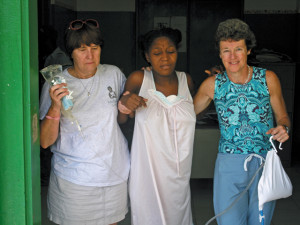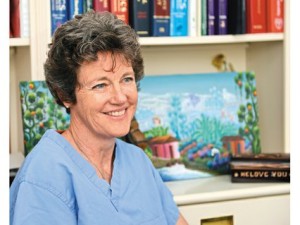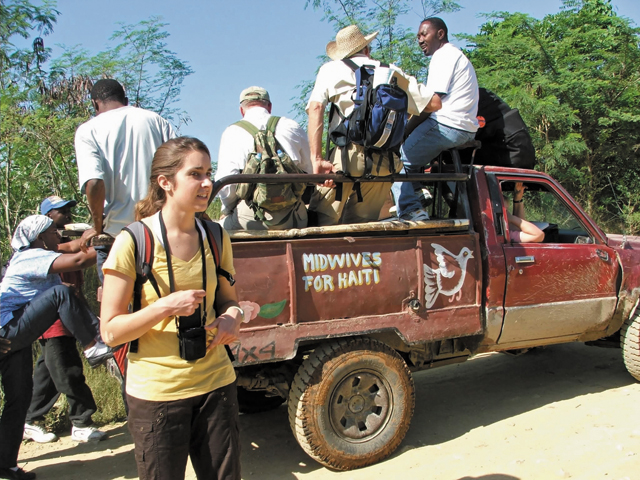With Midwives for Haiti, obstetrician Alice Hirata helps community members help each other
Joan Tupponce

Hirata (right) with a patient at St. Therese Hospital.
The next morning, she traveled to the hospital. She immediately noticed that the hospital was running on generator power that was hit or miss. There was no running water. “It was overwhelming for me,” she says. “Supplies were at a real minimum. Family members had to bring their own food.”
A supervising physician asked if she was “one of the ladies with Midwives for Haiti,” because he needed someone who could assist a woman in the cholera tent who had miscarried. Hirata followed him to the patient. “I helped with her care and then spent shifts doing nursing,” she says. “I was hooked.” Now, she says, “I no longer give much thought or worry about how I will be used.”
Now one of the medical directors for Midwives for Haiti, Hirata learned about the organization from its founder, Nadene Brunk, a certified nurse midwife who is her colleague at the Virginia Women’s Center. “Nadene went on a medical mission to Haiti and was struck by the fact that almost every woman she spoke with had a mother, sister or friend who’d died in childbirth,” Hirata says. “They had no skilled birth attendants.”

Dr. Alice Hirata
Hospital Ste. Therese in Hinche, Haiti, serves as the organization’s clinical training site. It also ensures that round-the-clock care is available at the hospital’s maternity center, where it pays the salary of 13 skilled birth attendants. “The hospital has increased deliveries since our presence,” Hirata says.
Midwives for Haiti also provides training to traditional birth attendants (or matròns in Haitian Creole). These respected community members, both men and women, attend an estimated 70 percent of births in Haiti but usually do not have any formal safe-birth training. Matròns learn “clean birthing techniques,” as well as how to know when women need to seek a higher level of care.
Hirata loves the fact that the organization’s work has lifelong ramifications. “We are teaching and enabling people within communities to care for families in their community,” she says. “Our graduates become respected leaders in their communities. It is a wonderful, beautiful transition from learning to becoming strong individuals.”
The organization’s mobile prenatal clinic — a pink Jeep — is well known in the 20 communities it visits. “We originally had a pickup truck,” Hirata says. “We were able to get a custom-built Jeep through sponsorship.”
The Jeep was painted pink to match the color of the scrubs worn by the midwives or skilled birth attendants. “Our students and graduates are easily identified by the color of their scrubs. Communities recognize the Jeep, too,” Hirata says.
The mobile clinic’s midwives see more than 500 mothers each month, providing prenatal and postpartum care, education, vitamins, testing, treatment and medications. The Jeep can also be used to transport women to the hospital. “It’s an amazing resource,” Hirata says.

The organization’s original pickup truck
Hirata tries to go to Haiti for two weeks each year, but she has stayed as long as three weeks. She is seeing slow but steady progress. Since the earthquake in 2010, for example, some of the roads have been paved, making it easier for health care teams to get around. “We pass by goats and chickens and people walking,” she says. “We ford streams. For the most part, the roads are pretty reliable.”
Even when she’s back in the States, Hirata carries Haiti in her heart daily. “I feel spiritually grounded. I am a tiny drop in a sea of need, but yet it feels right to offer that,” she says. “People hear what is negative about Haiti, but there is warmth in how I have been welcomed. I have developed wonderful relationships there. They have a sense of community and joy and spirituality. They take joy in every day. They have given back to me, a lot.”
